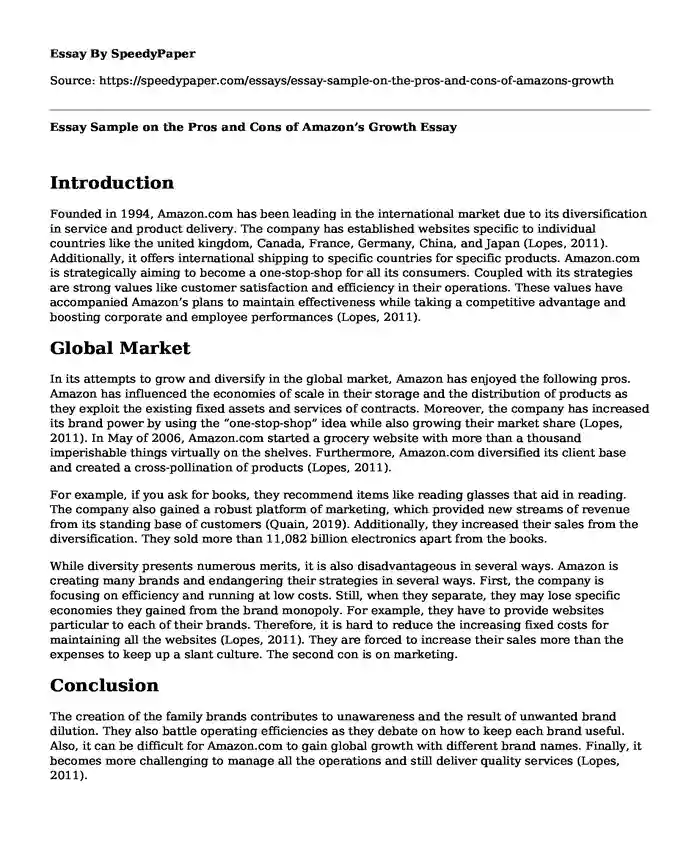Introduction
Founded in 1994, Amazon.com has been leading in the international market due to its diversification in service and product delivery. The company has established websites specific to individual countries like the united kingdom, Canada, France, Germany, China, and Japan (Lopes, 2011). Additionally, it offers international shipping to specific countries for specific products. Amazon.com is strategically aiming to become a one-stop-shop for all its consumers. Coupled with its strategies are strong values like customer satisfaction and efficiency in their operations. These values have accompanied Amazon’s plans to maintain effectiveness while taking a competitive advantage and boosting corporate and employee performances (Lopes, 2011).
Global Market
In its attempts to grow and diversify in the global market, Amazon has enjoyed the following pros. Amazon has influenced the economies of scale in their storage and the distribution of products as they exploit the existing fixed assets and services of contracts. Moreover, the company has increased its brand power by using the “one-stop-shop” idea while also growing their market share (Lopes, 2011). In May of 2006, Amazon.com started a grocery website with more than a thousand imperishable things virtually on the shelves. Furthermore, Amazon.com diversified its client base and created a cross-pollination of products (Lopes, 2011).
For example, if you ask for books, they recommend items like reading glasses that aid in reading. The company also gained a robust platform of marketing, which provided new streams of revenue from its standing base of customers (Quain, 2019). Additionally, they increased their sales from the diversification. They sold more than 11,082 billion electronics apart from the books.
While diversity presents numerous merits, it is also disadvantageous in several ways. Amazon is creating many brands and endangering their strategies in several ways. First, the company is focusing on efficiency and running at low costs. Still, when they separate, they may lose specific economies they gained from the brand monopoly. For example, they have to provide websites particular to each of their brands. Therefore, it is hard to reduce the increasing fixed costs for maintaining all the websites (Lopes, 2011). They are forced to increase their sales more than the expenses to keep up a slant culture. The second con is on marketing.
Conclusion
The creation of the family brands contributes to unawareness and the result of unwanted brand dilution. They also battle operating efficiencies as they debate on how to keep each brand useful. Also, it can be difficult for Amazon.com to gain global growth with different brand names. Finally, it becomes more challenging to manage all the operations and still deliver quality services (Lopes, 2011).
References
Lopes, J. (2011). The pros and cons of Amazon’s growth and diversification. Jananomba.blogspot.com. Retrieved 24 September 2020, from
http://jananomba.blogspot.com/2011/06/pros-and-cons-of-amazons-growth-and.html.
Quain, S. (2019). Advantages & Disadvantages of a Global Strategy. Small Business - Chron.com. Retrieved 24 September 2020, from
https://smallbusiness.chron.com/advantages-disadvantages-global-strategy-11664.html.
Cite this page
Essay Sample on the Pros and Cons of Amazon's Growth. (2023, Dec 12). Retrieved from https://speedypaper.net/essays/essay-sample-on-the-pros-and-cons-of-amazons-growth
Request Removal
If you are the original author of this essay and no longer wish to have it published on the SpeedyPaper website, please click below to request its removal:
- Free Essay Describing the Benefits of Travelling
- Concept Proposal Essay Example: Vancouver Sports Hotel
- Free Essay with Walmart's Vision and Mission Statement Evaluation
- Paper Example: Research on Methods of Financial Information System
- Business Ethics Essay Sample: Nissan Cars Case, Insider Trading and Other Ethical Dilemmas
- Paper Example. New York Theatre
- Essay Example - Information Technology and Monopolies
Popular categories





